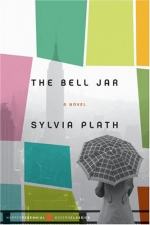|
|
The Bell Jar Objects/Places
Rosenbergs: The American couple executed in 1951. They were executed for allegedly acting as spies for American enemies, passing on nuclear secrets. The execution is primarily a touchstone in Esther’s memory. She does not comment about their deed or whether or not they are guilty. She merely says that she is glad they are dying.
New York City: Home to most publishing houses, this is where Esther must go when she wins a contest with a magazine. In New York, she meets many people and experiences things she would never have imagined. What might first have been a symbol of freedom and hope for Esther before moving there, New York becomes a dark and hated place by the time she leaves.
Amazon: The hotel for women where the young assistant editors stay. Men are not allowed to enter the building. All the girls have their rooms clustered together as if it were a college dormitory.
TB: Tuberculosis is a serious disease that was all but eliminated by medicine and vaccines by the end of the 20th century. If it is detected early on, it is painful but treatable. Buddy Willard contracted it working as a medical student. He was shipped to a sanatorium, where he continued to study medicine while he healed. It is his TB that prevents Esther from dumping Buddy earlier.
crabmeat: The eleven assistant editors were served crabmeat at the Ladies’ Day magazine food testing banquet. They all ate it and became seriously ill. Esther lies in the bathroom puking all night. Her food poising marks the first of many falls in her downward spiral.
Ladies Day Magazine: Ladies’ Day Magazine is a woman’s magazine like Good Housekeeping. It is at their banquet that the girls get food poisoning. As an apology, they send the girls gifts. Esther receives a book of short stories in which she reads the story of the Jewish man, the nun, and the fig tree.
Diamond Pin: Marco, Lenny Shepherd’s friend, gives Esther a diamond pin when he is introduced to her. The pin is supposed to impress her. It seems that Marco expects the pin to guarantee sex or at least some sort of sexual encounter, because when Esther punches him in the nose, he asks for it back.
Shock Therapy: A therapy practiced by psychiatrists in the fifties, sixties and early seventies. A certain amount of electric current is run through the temporal lobes. The temporal lobes produce anger and anguish, and psychiatrists believed they could be ‘re-calibrated’ with electric current. Esther’s first experience with this is disastrous and it may have contributed to her deepening mental instability. Her later experience seems to have been successful. Modern psychiatrists dismiss electroshock therapy.
Occupational therapy: Another type of therapy. Occupational therapy is any sort of activity that involves peacefully using your body. In this book, it primarily means some sort of arts and crafts. It can mean anything that involves rudimentary or complex motor skills.
Wymark: The lowest ‘level’ of housing at Esther’s private hospital. Wymark is where the worst cases go.
Caplan: The middle or ‘entry’ level at the private hospital. From Caplan, a patient can either improve and move up to Belsize, or founder and move down to Wymark.
Belsize: The highest level at the private hospital. Patients at Belsize have more privileges than others. This is the last step before they enter normal society.
Walton: The hospital in Esther's home town where Dr. Gordon administers her shock treatment. Walton confuses her because it looks like a normal house, yet it houses people with psychological problems.




